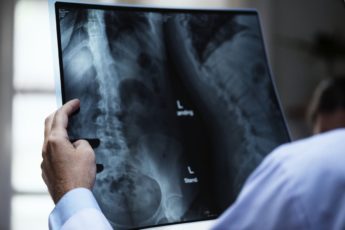
READING TIME: 3 MIN
Right around Gabriella’s first birthday, Lisa got pregnant for the second time.
We really wanted this, sure it would benefit all three of us, but the sight of that blue plus-sign on the home pregnancy test was frightening.
One day soon after, Lisa called the geneticist’s office and spoke with a genetic counselor that we had gotten to know. When she shared our good news, she heard a gasp. “I’m so sorry to hear that,” the counselor said.
Last week I wrote about our earlier trip to the geneticist, about the diagnosis and the three-part prophecy that accompanied Opitz trigonocephaly, like three curses in a fairy tale. Now we were approaching the end of the first year, staring down the threshold for Opitz babies. Suddenly we encountered a second curse, the one-in-four chance that any future child would be stricken with the same condition. When the geneticist had first explained this, I stammered that we wanted other children. What were we supposed to do? “Most parents we see in this situation just decide not to have any more children,” the geneticist said. “Or they adopt.”
We had been undeterred.
But with all we’d gone through already and the many challenges that lay ahead, the prospect was daunting. And while we remained skeptical about the Opitz diagnosis itself, we did believe Gabriella had a genetic syndrome. Remembering my high school science class, examining classmates for attached earlobes and curled tongues, I suspected that whatever they called it, her condition could yet recur in this next child.
Because of our situation, they had us in for genetic counseling, at which time they encouraged us to undergo a chorionic villus sampling. CVS consisted of removing a tissue sample from the fetus with a needle. The test would tell us whether this second child had Opitz, but Lisa discovered that its very application could cause birth defects. We declined.
At the same time, we thought back to Gabriella’s birth, to the discovery that she was different from other kids. We couldn’t face another surprise.
Then came another scare. Around the same time, we had an alpha fetoprotein test, and this came out abnormal. This meant our second child now had a higher chance of Down’s syndrome.
What were we to do now? Take the CVS and risk further harm, or risk another birth-date filled with awful surprises?
We learned about an alternative test, a more sophisticated form of ultrasound able to tell whether the baby in utero had Down’s, among other abnormalities. It could also show the presence of contractures. Often based on the length of the tendon, contractures reflect a tightness in the joint, limiting the degree to which she can bend her wrists, her knees, her ankles, and many other joints. Gabriella’s contractures were related to her arthrogryposis, another manifestation of her syndrome. No contractures would mean this little one didn’t have the same syndrome.
We got excited. They’d do the Level II Ultrasound at twenty weeks. While not definitive, this test could relieve a lot of anxiety. Worst case scenario: we’d have time to get used to the idea of another baby with multiple disabilities.
We returned at the appointed time to the geneticist’s office, which at this point was not one of my favorite places. The genetic counselor stopped us outside and asked, “Will it make a difference, the ultrasound?”
“It’ll make a big difference to us,” Lisa said. She made it clear that we would have the baby regardless.
Soon the technician squirted gel onto Lisa’s belly and wound the sensors in circles. I watched the monitor and clutched her hand. The technician pointed out the head, the arms, the legs. Soon we discovered we were having a boy, but still we held our breath.
“He’s quite active,” the radiologist said. “He’s flipped over just since we started.”
Then the geneticist entered, arms crossed. We awaited the ultimate verdict.
As a medical professional, Lisa more easily recognized the image floating on the screen, and I looked to her. Both of us watched the geneticist with a sense of panic. “See that?” the radiologist said. “That’s the baby’s hand.”
Then the geneticist spoke. “Just that alone. It couldn’t do that if it had Opitz.”
With a surge of joy, I peered at the ghostly hand on the screen, and then I saw the miracle at the end of the geneticist’s pointing finger. Our son was giving us the thumbs-up.








Paul, thanks for sharing. A special 🖒to you and your family.
Thanks, Pete! I appreciate you viewing and sharing.
Paul
Paul,
I just sent an email to a mutual friend who shared your blog with me. I said that I speak your language, or maybe you speak mine. I feel like we are veterans of a war that no one talks about. Bonded by the shared experiences that most others cannot really know. My oldest daughter is almost 20, so we have been on parallel paths. Thanks for sharing your story so eloquently. I look forward to reading more.
Hi Kathy,
I really appreciate your message. I feel like there are so many of us with shared experiences, similar and yet each unique in our own way. And I think it’s time we start talking about it.
Paul